A Kanban board for marketing helps organize your projects visually, ensuring tasks move smoothly from start to finish. This article will explore different Kanban board examples and how to set them up for various marketing activities like content creation, social media planning, and event management. Learn how this method can streamline workflows and improve your team’s productivity.
Key Takeaways
- Tailoring Kanban boards to specific marketing tasks, such as content creation, social media planning, and event management, improves organization and efficiency.
- Using a marketing Kanban board enhances workflow transparency and accountability, allowing teams to visualize task statuses and manage workloads effectively.
- Customization and effective management of task dependencies on Kanban boards are crucial for maintaining productivity and ensuring projects remain on track.
4 Kanban Board Examples for Marketing
Marketing initiatives vary in their requirements, necessitating different Kanban boards. These boards streamline specific marketing tasks, from content creation to social media planning and video production. Tailoring the Kanban system to your needs ensures organized and efficient marketing efforts.
N°1 : The Simple Content Marketing kanban Board

This simple Kanban board is highly effective for content marketing teams. Typically, it includes columns like Ideas, Research, creating, editing, scheduled and published. Visualizing the process from brainstorming to publication. This structure effectively manages tasks such as blog content, social media content, video, podcast and much more…
Once a piece of content is reviewed, it either moves to the Done column or back to In Progress if more work is needed. This process ensures that nothing slips through the cracks and that all your marketing projects are meticulously tracked. You can use this board for free with RingTheBell and also invite unlimited collaborators.
N°2 : The Social Media Marketing Planning Kanban Board
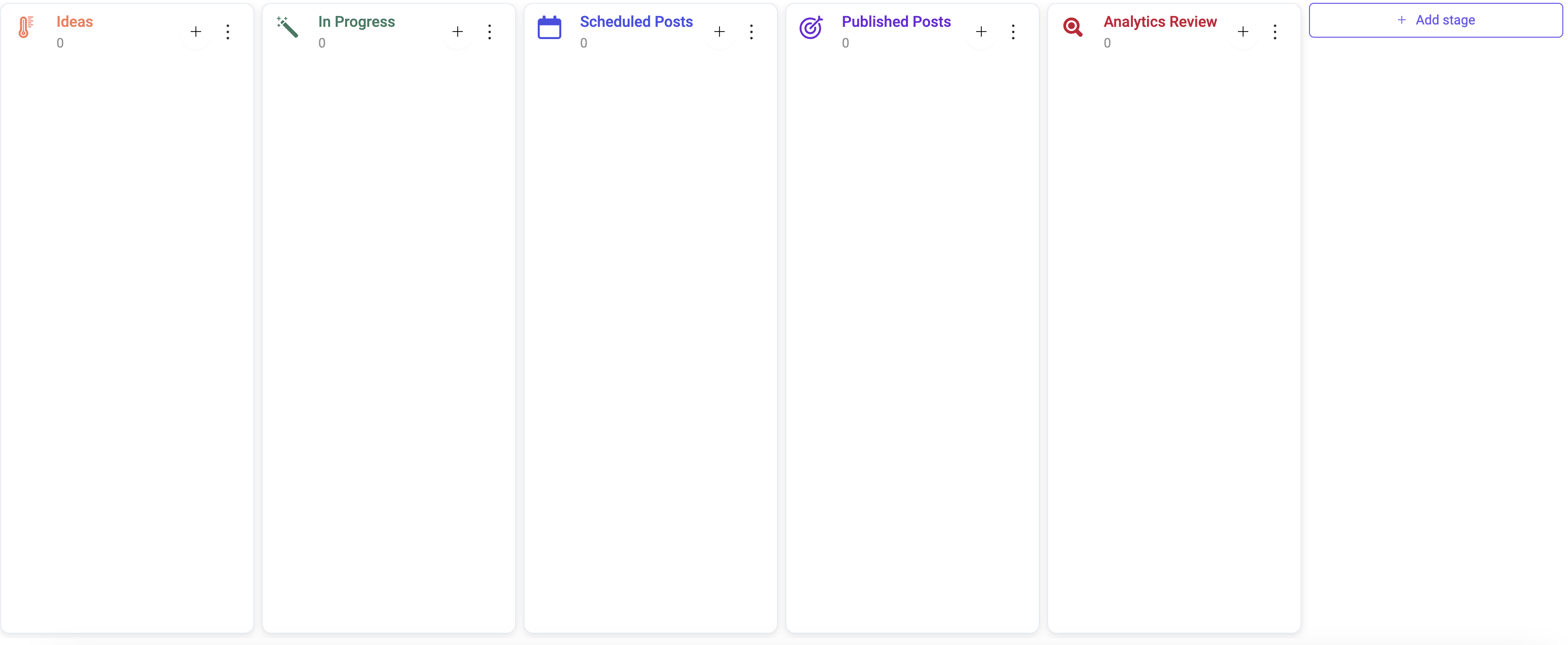
A social media planning board organizes content and schedules posts efficiently. It helps marketing teams coordinate efforts, ensuring timely posts and accountability for each task. Each task represents a social media post, including content, graphics, and videos.
Once a post is published, it moves to the analytics section, making it easy to track what has been done and when. Tags for different social media channels can be used to filter posts, streamlining content management even further.
N°3 : The blog content marketing board
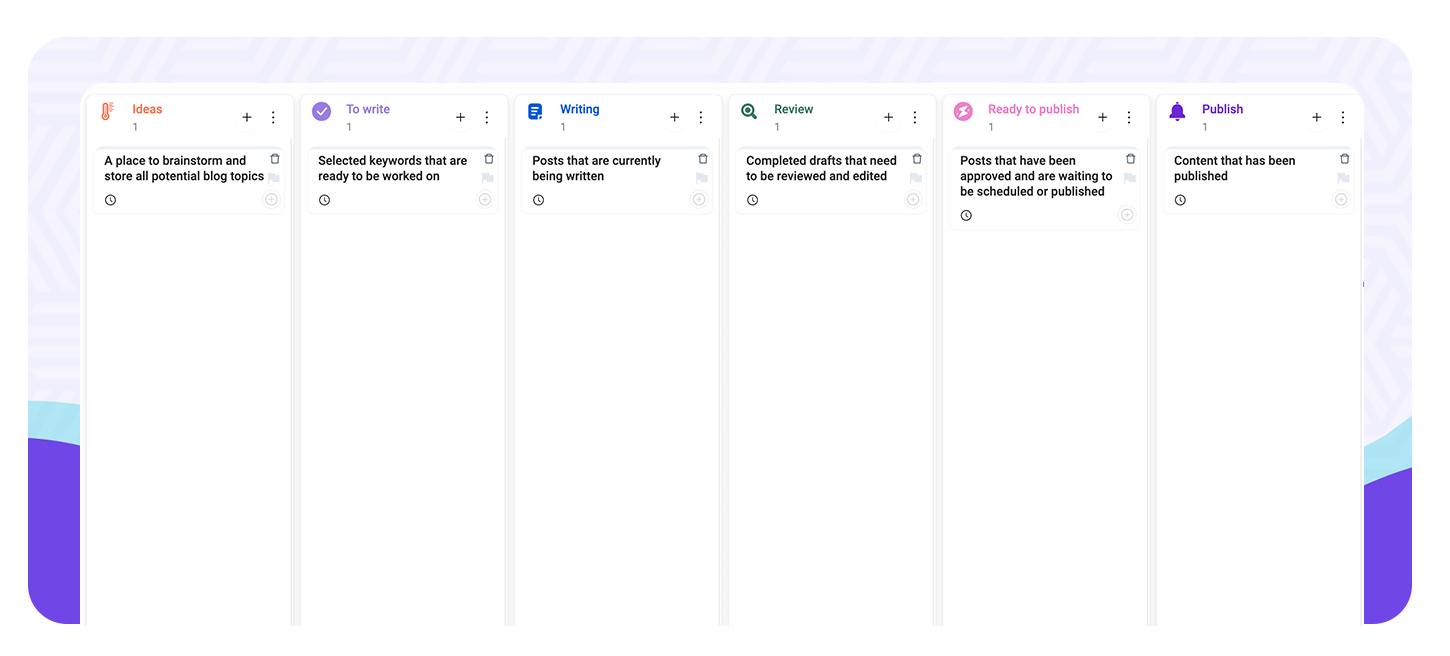
This marketing Kanban board is designed to streamline your blog content marketing process, ensuring that every piece of content moves smoothly from concept to publication. It provides a clear and organized workflow, helping you track the status of each blog post and maintain a consistent publishing schedule. The stages on this board are tailored specifically for content marketing teams or individual bloggers.
Moving tasks through these columns helps marketing teams track what needs to be done and what is ready for execution, ensuring no detail is overlooked. This approach streamlines the entire blog content publishing.
N°4 : The marketing board for video production
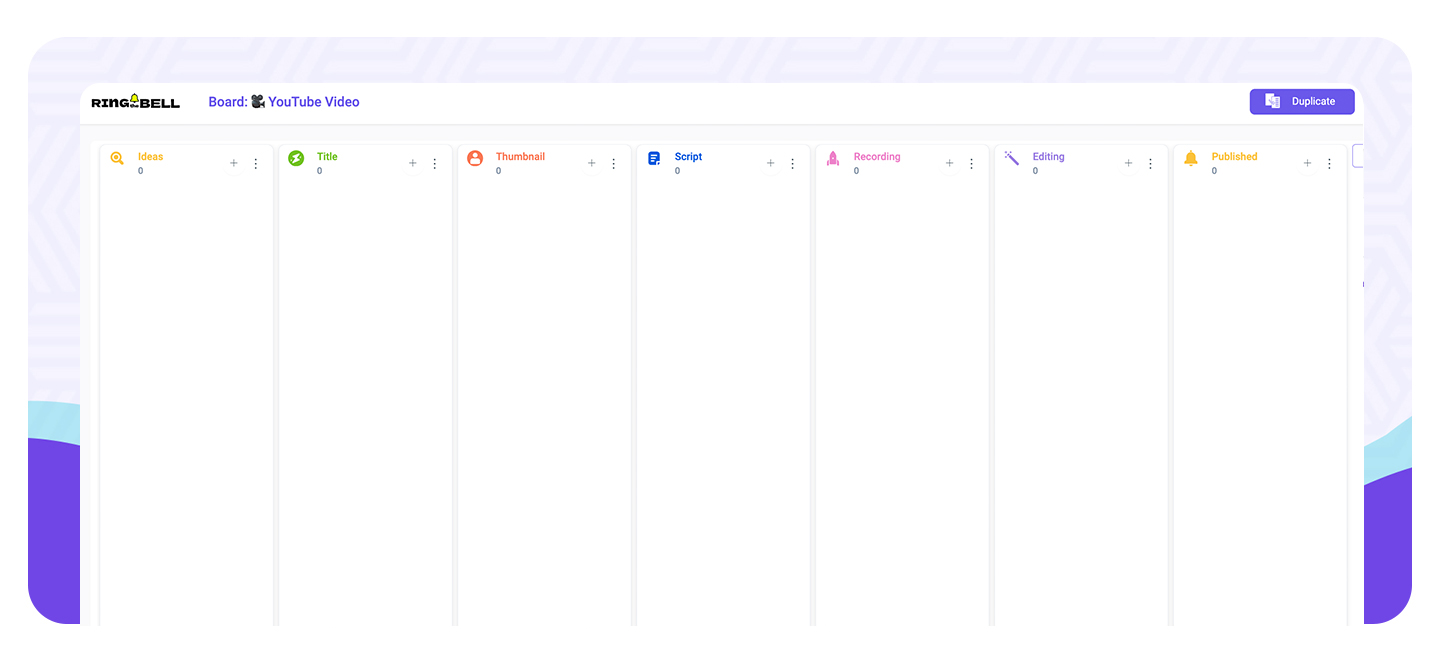
This marketing board is designed to optimize your video production workflow, from initial concept to final distribution. It provides a clear and structured process, ensuring that every video project moves efficiently through each stage of production. Whether you’re part of a team or managing the process solo, this board helps you stay organized and on track with your video marketing efforts.
You can discover all kanban board templates on our website RingTheBell.
Understanding Kanban for Marketing
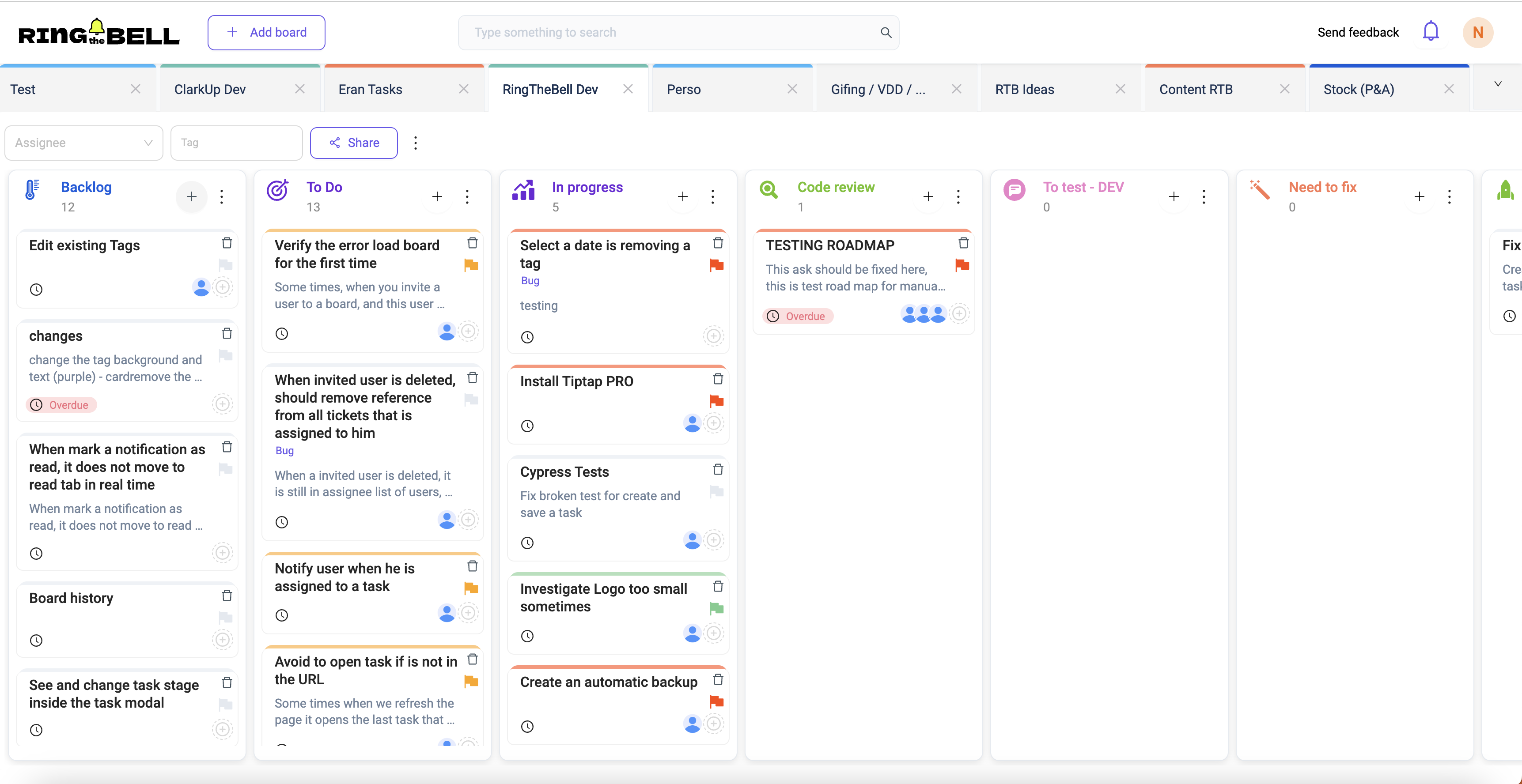
Originally developed by Toyota in the 1940s, the Kanban method has been adapted for various industries, including marketing. A marketing Kanban board organizes and tracks projects, offering a visual overview of steps and workflow stages. This method aligns with the lean approach, focusing on efficiency and continual improvement.
A marketing Kanban board addresses common challenges like disorganization and managing multiple projects. Visualizing workflows and task flow management helps streamline tasks for agile marketing teams and meet project deadlines.
Regular meetings maintain a prioritized backlog, addressing the most critical tasks first. An idea backlog saves ideas without distracting ongoing work, making the Kanban system invaluable for all marketing projects, from social media campaigns to product launches.
Key Elements of a Marketing Kanban Board
A marketing Kanban board displays task stages, enhancing workflow transparency. Tasks represent specific marketing activities or deliverables, complete with details such as deadlines and assignees in agile marketing. The marketing team utilizes this approach to streamline processes.
A basic layout for marketing Kanban boards typically includes three columns: To Do, In Progress, and Done, with optional columns like Review for feedback management. These boards can be created using software tools, project management platforms, whiteboards, or sticky notes, offering implementation flexibility.
Benefits of Using Kanban board for Marketing

The Kanban framework enhances transparency by visualizing tasks, deadlines, and project statuses. This improves visibility and accountability, ensuring nothing falls through the cracks. Work-in-progress limits prevent team members from juggling too many tasks, helping them manage workloads better.
Kanban promotes continuous improvement by enabling teams to adapt their processes based on unique contexts. This flexibility makes it easier to implement than methodologies like Scrum, resulting in smoother workflows and increased productivity.
Setting Up Your Marketing Kanban Board
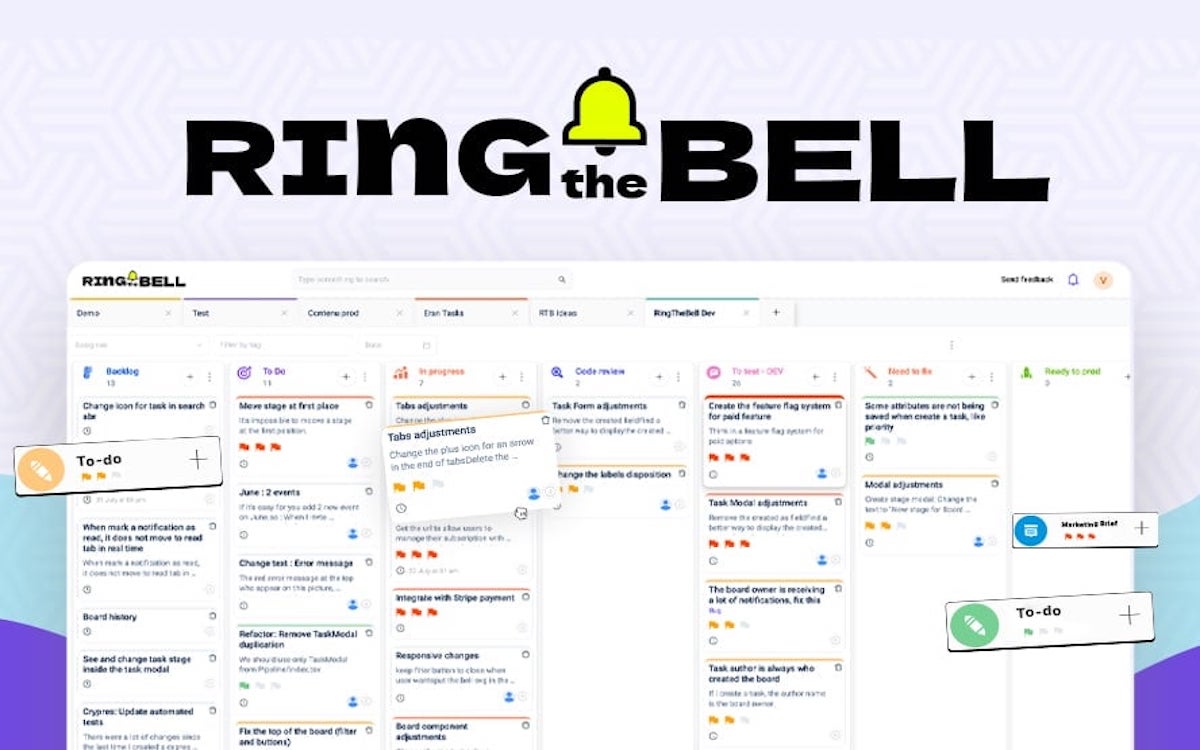
To create a marketing Kanban board, first identify the workflow and essential tasks. Establish a basic layout and define columns based on the team’s workflow. Project statuses generally move from left (project beginning) to right (project completion) on a Kanban board.
You can use for free RingTheBell to create your first kanban board.
A commitment point marks where ideas are selected for action, indicating the project’s start on the Kanban board. Set team policies to clarify responsibilities for card management and workflow reviews.
Customizing Your Kanban Workflow for marketing
Customization is crucial for Kanban boards in marketing, allowing transparent process mapping and adaptation to team needs. Columns on a Kanban board reflect specific workflow stages, such as To Do, In Progress, and Done.
For content workflows, Kanban boards should feature custom statuses like blog posts, email campaigns, and ebooks. Email marketing boards may include a Verify Metrics column to assess campaign effectiveness before finalizing them.
Managing Task Dependencies
Dependencies in projects refer to task relationships, where one task must be completed before another starts. There are four main types: mandatory, discretionary, external, and internal. Visualizing dependencies on a Kanban board helps teams prioritize tasks.
Linking tasks on a Kanban board facilitates better dependency management and enhances team coordination. Effective management aids in planning resources and scheduling tasks to organize tasks, improving overall project predictability.
Assigning Tasks and Tracking Progress
Assigning tasks to individuals ensures accountability within marketing teams. The project manager usually monitors task progress, ensuring clarity in responsibilities. Designating a project manager for tasks helps clearly assign responsibilities and track progress.
Instantly logging task updates keeps the Kanban board current and reflects real-time progress. Keeping the board clean by mapping out workflows before adding tasks is crucial.
Utilizing Kanban Metrics
Limiting work-in-progress is a key Kanban principle that enhances productivity. Establishing WIP limits helps teams manage workloads and minimize waste, ensuring a specific number of tasks can be active in each column at one time.
Monitoring cycle time and throughput helps teams identify workflow bottlenecks. The Kanban approach promotes agility by measuring cycle time, leading to faster task completion. Control charts visually represent cycle time data, identifying trends and instabilities in workflow.
Tips for Running Effective Standup Meetings
Daily stand-up meetings should focus on quick updates about task progress and identifying obstacles. Keeping these meetings short and to the point helps maintain team momentum and address immediate attention needed for specific tasks, ensuring that each team member is aligned.
Tools to Enhance Your Marketing Kanban Board

Automating task assignments streamlines delegation, saving time for managers. Tools like RingTheBell is simple to use and free. You can also manage Kanban boards directly from Slack, integrating task management into team communications. Taskworld allows adding tasks to multiple Kanban projects simultaneously, enhancing efficiency.
Kanban Tool offers robust analytics features to track time spent on tasks, while Kanbanchi integrates seamlessly with Google Workspace, allowing tasks to be created directly from Gmail.
KanbanFlow includes a built-in Pomodoro timer for effective work session management, and MeisterTask features an Agenda option displaying tasks needing daily attention.
Summary
In summary, a marketing Kanban board is an invaluable tool for organizing and managing marketing projects. By visualizing workflows, managing dependencies, and utilizing metrics, marketing teams can achieve greater efficiency and productivity. Customizing the board to fit specific needs and using the right tools can further enhance its effectiveness.
Implementing a Kanban board in your marketing strategy will not only streamline your processes but also foster a culture of continuous improvement. Start today and watch your marketing efforts soar to new heights!
Frequently Asked Questions
What is a marketing Kanban board?
A marketing Kanban board is a visual management tool designed to help you organize and track marketing projects effectively, ensuring efficient task completion. This method enhances clarity and workflow within your marketing team.
How do I set up a marketing Kanban board?
To set up a marketing Kanban board, first identify your workflow and key tasks, then create a layout with columns reflecting that workflow. Ensure to define responsibilities and establish team policies for effective board management. Use the tool RingTheBell for free to create your boards.
What are the benefits of using Kanban in marketing?
Using Kanban in marketing enhances transparency and improves workload management, allowing teams to focus better and continuously improve their processes. This approach streamlines workflow and boosts overall efficiency.
How can I customize my Kanban workflow?
To customize your Kanban workflow, adapt columns to represent distinct workflow stages, incorporate custom statuses, and establish WIP limits for better workload management. This tailored approach enhances efficiency and clarity in your process.
What tools can enhance my marketing Kanban board?
Utilizing tools such as RingTheBell, Workstreams, Kanban Tool, and MeisterTask can significantly enhance your marketing Kanban board by streamlining task management and providing advanced functionality. Consider integrating these tools for improved efficiency and collaboration.



